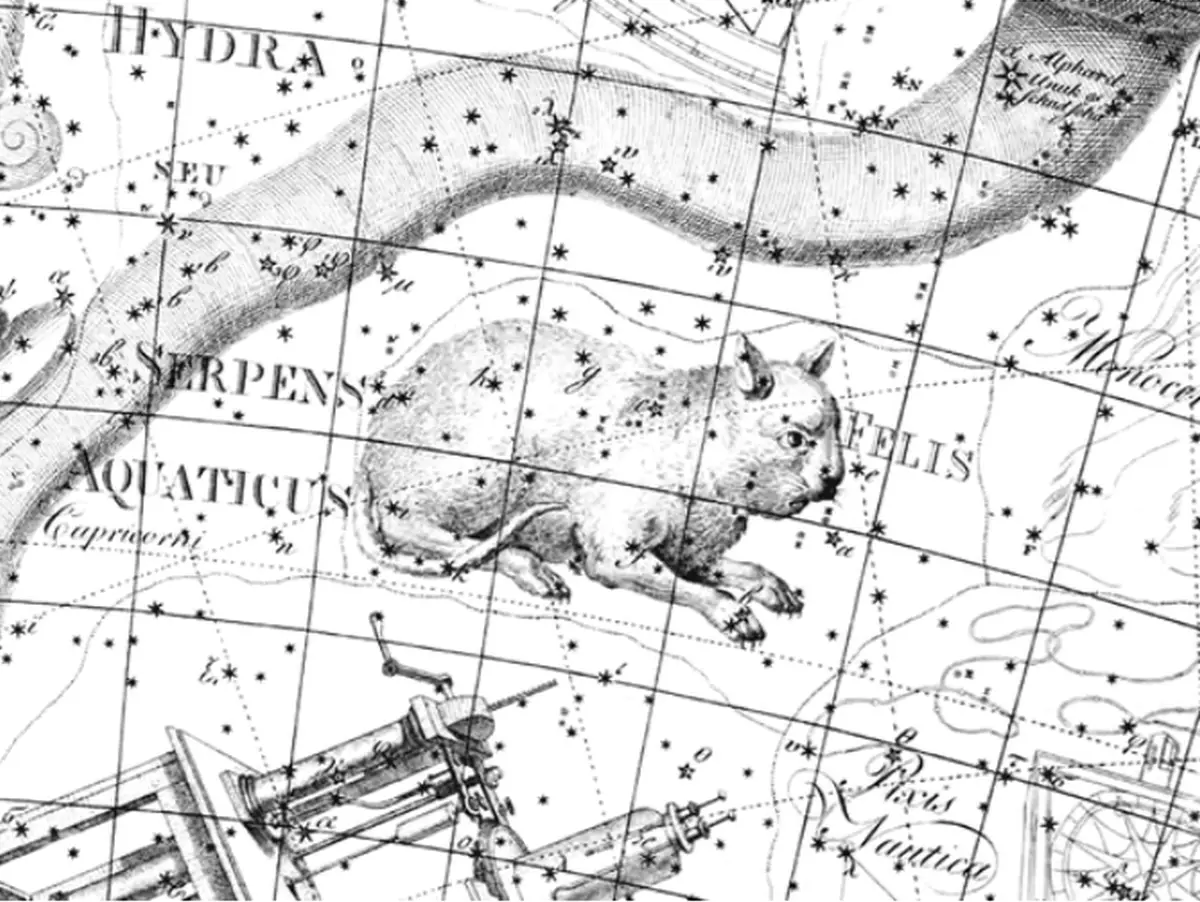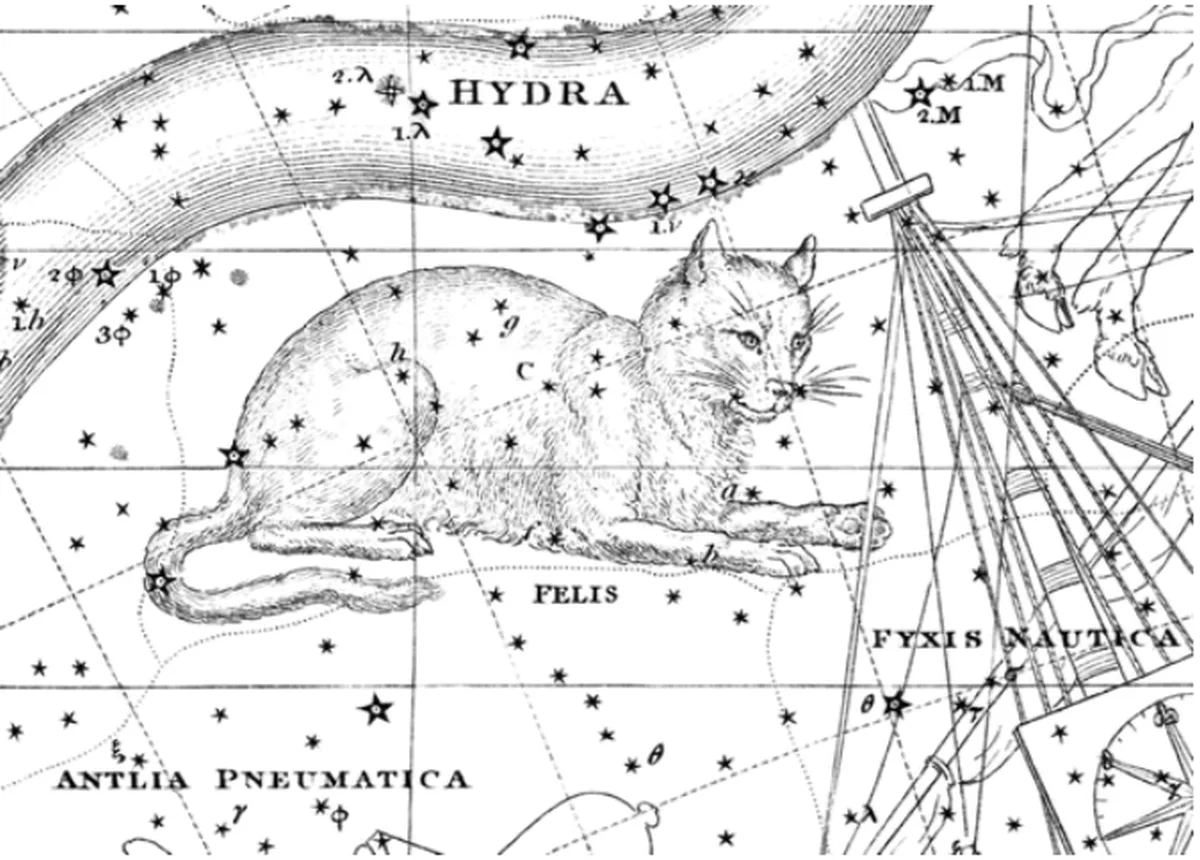Felis (the Cat) was a former constellation introduced by the French astronomer Jérôme Lalande in 1799. The Cat constellation consisted of faint stars between the main constellation patterns of Hydra (the Water Snake) and Antlia (the Air Pump). The brightest stars in Felis shone at 5th magnitude, making the celestial Cat fairly inconspicuous in the night sky.
Jérôme Lalande created the constellation to fill the faint area south of the neck of Hydra. He named it Felis (le Chat) because he was a cat lover. Even though there were already three members of the feline family in the sky – Leo (the Lion), Leo Minor (the Lesser Lion), and Lynx – the French astronomer regretted that there was not yet a domestic cat among the constellations, especially when there were as many as three dog constellations (Canis Major, Canis Minor, and Canes Venatici). Lalande was inspired to by a poem on cats written by the French politician and lawyer Claude-Antoine Guyot des Herbiers.
Felis was first depicted in the German astronomer Johann Elert Bode’s star atlas Uranographia sive Astrorum Descriptio, published in 1801. Lalande never depicted the constellation on a star chart himself, but suggested it to Bode, providing the German astronomer with star positions.

Felis as shown on Plate 19 of Bode’s Uranographia (1801)
Lalande later wrote in his Bibliographie astronomique, avec l’histoire de l’astronomie depuis 1781 jusqu’à 1802 (1805):
“The large number of stars I supplied to M. Bode gave me some right to shape new constellations. There were already thirty-three animals in the sky; I put in the thirty-fourth one, the cat, in reference to the charming poem of which representative Desherbiers published some verses. This new constellation of the Cat is between Hydra and the Ship [Argo Navis]; it has already been engraved in Germany, and it is included in Mr. Bode’s new celestial atlas.”
After its publication in Bode’s Uranographia, the Cat constellation made an appearance in several atlases published in the 19th century. August Gottlieb Meissner included it as Katze in his Astronomischer Hand-Atlas in 1805. Alexander Jamieson depicted it in his Celestial Atlas of 1822. James Middleton included the Cat on Plate 3 (“Spring”) of his Celestial Atlas of 1842, and Ezra Otis Kendall mentioned the constellation as lying “between Hydra and the Compass” in his Uranography.
Ludwig Preyssinger depicted the “Chat” on Plate II of Astronomie Populaire ou Description des Corps célestes in 1862. In 1878, Felis appeared in Simon Newcomb’s Popular Astronomy. Father Secchi included it as Gatto on his planisphere of 1878. One of the constellation’s final appearances on a popular map was in Eliza A. Bowen’s Astronomy by Observation (1888).

“Noctua, Corvus, Crater, Sextans Uraniæ, Hydra, Felis, Lupus, Centaurus, Antlia Pneumatica, Argo Navis, and Pyxis Nautica”, plate 32 in Urania’s Mirror, a set of celestial cards accompanied by A familiar treatise on astronomy… by Jehoshaphat Aspin. London, 1825. Astronomical chart, 1 print on layered paper board: etching, hand-colored.
Felis is one of the several obsolete constellations created or introduced by Bode through his published star charts. Others included Custos Messium (the Harvest Keeper), Globus Aerostaticus (the Hot Air Balloon), Honores Friderici (Frederick’s Glory), Machina Electrica (the Electrical Generator), Officina Typographica (the Printing Office), and Quadrans Muralis (the Mural Quadrant).
The brightest star in Felis was the red giant HD 85951 (HR 3923). The massive star has an apparent magnitude of 4.94 and lies approximately 520 light years away. The International Astronomical Union (IAU) formally named the star Felis on June 1, 2018. The star now belongs to the constellation Hydra. The red clump giant G Hydrae (mag. 4.69) was another member of the constellation.
The constellation Felis was mostly adopted in Europe. American astronomers largely omitted it from their maps. In the last two decades of the 19th century, the Cat started to disappear from European maps as well. Its stars were assigned to the neighbouring Hydra, Pyxis and Antlia.

Felis depicted on Plate XXVI of Alexander Jamieson’s Celestial Atlas (1822)
In 1882, the French astronomer Camille Flammarion argued that the constellation was “more than superfluous,” noting that it had disappeared from modern star maps.
By the end of the 19th century, the constellation fell into disuse. In his 1899 book Star Names: Their Lore and Meaning, Richard Hinckley Allen wrote that Felis “has long been discontinued in the catalogues and charts.” When the International Astronomical Union (IAU) defined the list and boundaries of the modern constellations in the early 20th century, Felis was omitted.
Among the other celestial cats, only Leo (the Lion) is an ancient constellation, listed by the Greek astronomer Claudius Ptolemy in the 2nd century CE. Leo Minor (the Little Lion) and Lynx were introduced by the Polish astronomer Johannes Hevelius in 1690. All three are among the 88 modern constellations.

Felis, Sextans, Hydra and Crater, credit: Alexander Jamieson (1822)